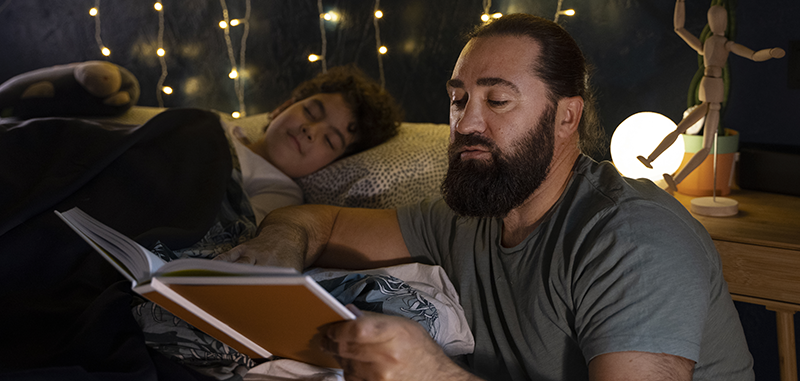Invent a story for your child: all our tips!

Telling your child a story is a special opportunity to share a real moment of connection at bedtime.
Who doesn’t remember a magical world filled with treasure, monsters, and princesses from their own childhood?
Reading is a beloved activity for children of all ages — but let’s be honest: reading a story is great, but making one up just for them is even better!
More than just quality time, these stories spark curiosity, boost creativity, and can gently teach important lessons — all while having fun. So how do you get started? Here’s your personal step-by-step guide to creating a story just for your child!
Step One: Set the Mood
Before switching from your role as a parent to that of a master storyteller, it’s important to create an atmosphere that invites imagination.
Start by slightly lowering the lights in the room. Dim lighting helps your child focus on your voice — and it makes the hidden treasures and magical objects shine even brighter!
Get comfy next to your child and enjoy the fact that you’re not reading from a book — this is your chance to make eye contact. Take a deep breath and speak the magic words: "Once upon a time..."

How to Start Your Story
Rule #1: Set the Scene
It’s essential to begin by setting the scene. When creating a story with your child, the most important choice is that of the main character.
And the golden rule is: no limits! Children are wonderfully open to all kinds of stories.
Don’t be afraid to be silly or unusual — choose characters you both enjoy!
Start by giving a brief description of the character: a dragon with a toothache, a tiny elf who could hide in a pencil case...
Feel free to draw inspiration from your child’s current interests or worries, and above all, keep descriptions short and sweet.
If you’re struggling to begin, here are a few useful tips:
Rule #2: Introduce the Plot Twist
A good story truly begins when something goes wrong.
Once the setting and characters are in place, it’s time for them to face some challenges! This is your chance to add some wild and unexpected twists: the kingdom’s evil king locks up all the children, a huge storm is about to hit...
👉 Or, you can choose to send a message that relates to something your child is going through: an argument between friends or a bad grade at school.
Stories help introduce obstacles — and more importantly, the right mindset to overcome them.
Running low on inspiration? Don’t put too much pressure on yourself: storytelling is, above all, a fun and shared moment! And don’t worry — it’s perfectly fine to “borrow” ideas from books or movies you already know!
Rule #3: Bring It to a Close
Now that your story has taken shape, it’s time to find the right ending.
Faced with a challenge, your hero will need to figure out how to solve it.
Introduce one or two friendly characters whose appearance helps the main character learn something important. Whether it’s a value like kindness or respect, or a helpful habit like washing hands properly — it’s entirely up to you.
You can also symbolize that lesson with an object or a reward: a magic stone, a miraculous mirror, and so on...
Through these adventures, your hero will face the main challenge and restore balance to their world. Always try to wrap up the story, even if it’s short — a proper ending will reassure your child and help them drift off to sleep with sweet dreams.
A story can sometimes unfold over weeks — even months! Both you and your child may grow attached to the characters, making it easier (and more fun) to send them on new adventures.
Discover REMI
THE SMART BABY MONITOR 😊
REMI and its app bring together everything you need to manage your baby’s sleep!
Its mission? Helping families sleep better — from birth up to age 10.
I bought REMI for my 4-year-old son who didn’t want to sleep alone anymore after his little sister was born. Thanks to the remote wake-up system and bedtime stories I can play from a distance, the issue is completely resolved! I 100% recommend this purchase!






 My Child Won’t Sleep Alone: How to Help Them Gain Independence
My Child Won’t Sleep Alone: How to Help Them Gain Independence
 Letting Baby Cry It Out: Effective, But At What Cost?
Letting Baby Cry It Out: Effective, But At What Cost?
 White noise for baby : a scientific research !
White noise for baby : a scientific research !
 What are the positive effects of napping on memory?
What are the positive effects of napping on memory?
 What Time Should Your Child Go to Bed? The Ideal Bedtime by Age!
What Time Should Your Child Go to Bed? The Ideal Bedtime by Age!